Table of Contents
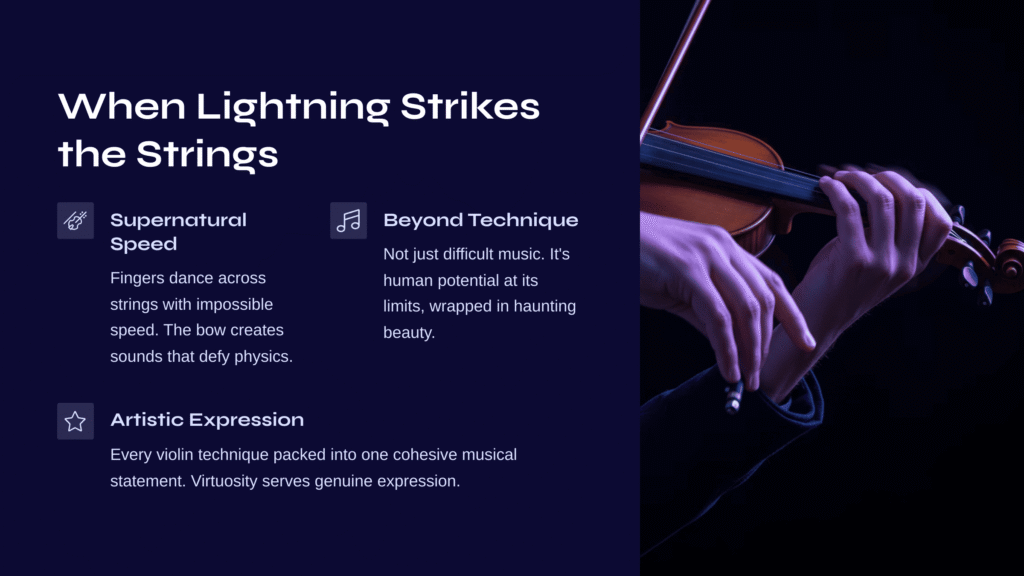
When Lightning Strikes the Strings
There’s something almost supernatural about watching a violinist tackle Paganini’s Caprice No. 24. The way their fingers dance across the strings with impossible speed, the bow creating sounds that seem to defy the laws of physics – it’s no wonder audiences once whispered that Paganini had made a deal with the devil himself. This isn’t just music; it’s a demonstration of human potential pushed to its absolute limits, wrapped in a melody so hauntingly beautiful that it has captivated composers and listeners for over two centuries.
What makes this particular piece so extraordinary isn’t just its notorious difficulty – though it certainly holds the title as one of the most technically demanding works ever written for solo violin. It’s the way Paganini managed to pack every conceivable violin technique into a single, cohesive musical statement that somehow never feels like a mere technical exercise. Instead, it stands as a testament to what happens when virtuosity serves genuine artistic expression.

The Man Behind the Legend
Niccolò Paganini was born in 1782 in Genoa, the son of a modest ship chandler who moonlighted as a musician. From the moment young Niccolò picked up the violin at age seven, it was clear that something extraordinary was happening. His talent was so prodigious that by his teens, he had already surpassed the abilities of his teachers, forcing his ambitious father to seek out the finest instructors across Italy.
The 24 Caprices, including our infamous No. 24, were composed between 1802 and 1817 during Paganini’s service under Napoleon’s sister, Élisa Bonaparte, who ruled Lucca. This period of relative stability allowed Paganini to experiment with techniques that would revolutionize violin playing forever. He wasn’t just writing music; he was reinventing what the violin could do.
Paganini’s reputation was built as much on mystery as on musical genius. His gaunt appearance, combined with abilities that seemed to transcend human limitations, led to persistent rumors about supernatural intervention. The Catholic Church’s initial refusal to provide him burial services only added to his mystique. But behind the legends was a methodical innovator who systematically explored every possibility the violin offered, pushing the boundaries of technique while never losing sight of musical beauty.
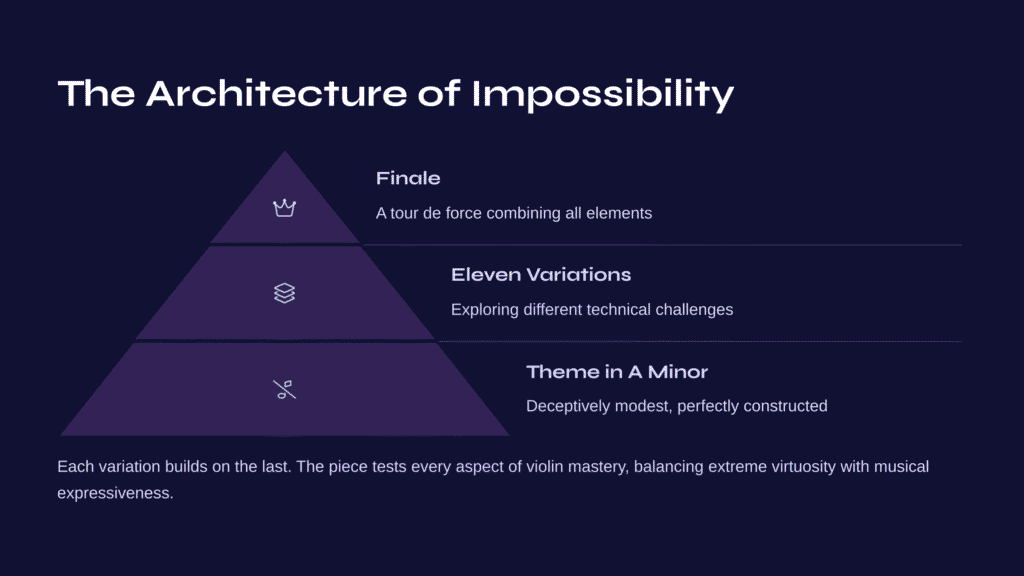
The Architecture of Impossibility
Caprice No. 24 follows a classical theme-and-variations structure – a seemingly simple framework that Paganini uses to showcase virtually every advanced violin technique known to humanity. The work opens with a deceptively modest theme in A minor, a march-like melody that establishes the dramatic character of what’s to come. Don’t be fooled by its apparent simplicity; this theme is perfectly constructed for variation treatment, with clear harmonic progressions and memorable melodic contours that remain recognizable even through the most elaborate transformations.
What follows are eleven variations that systematically explore different technical challenges. We’re talking about parallel octaves that require lightning-fast finger coordination, rapid scales and arpeggios that cover the violin’s entire range, left-hand pizzicato that demands ambidextrous mastery, and string crossings so quick they blur the line between music and magic. Each variation builds on the last, creating a cumulative effect that’s both musically satisfying and technically overwhelming.
The finale brings together elements from all the preceding variations in a tour de force that tests every aspect of violin mastery. It’s not enough to have fast fingers or perfect intonation – the performer must balance extreme virtuosity with musical expressiveness, making this as much a test of artistic maturity as technical proficiency. The result is a piece that has served as a rite of passage for elite violinists for over two centuries.

A Personal Journey Through Musical Fire
Listening to Caprice No. 24 is like witnessing a musical high-wire act where the stakes feel genuinely life-and-death. There’s an edge-of-your-seat tension that builds from the first notes, as you realize you’re about to witness something that pushes human capability to its limits. The theme plants itself in your memory immediately – it’s one of those melodies that feels both completely new and strangely familiar, like a half-remembered dream that suddenly becomes vivid.
As the variations unfold, you find yourself holding your breath during the most technically demanding passages, almost afraid that the spell might break if the performer misses a single note. But when everything clicks – when technical mastery serves genuine musical expression – the effect is transcendent. You’re not just hearing a violin; you’re experiencing the full range of human emotion compressed into sound waves that seem to bypass your ears and speak directly to your soul.
The emotional journey is as complex as the technical one. There’s drama, certainly, but also moments of surprising tenderness hidden within the virtuosic fireworks. Paganini understood that true virtuosity isn’t about showing off – it’s about using technical mastery to communicate something that couldn’t be expressed any other way. That’s why this piece has inspired everyone from Brahms to Rachmaninoff to contemporary composers who continue to find new meanings in its immortal theme.
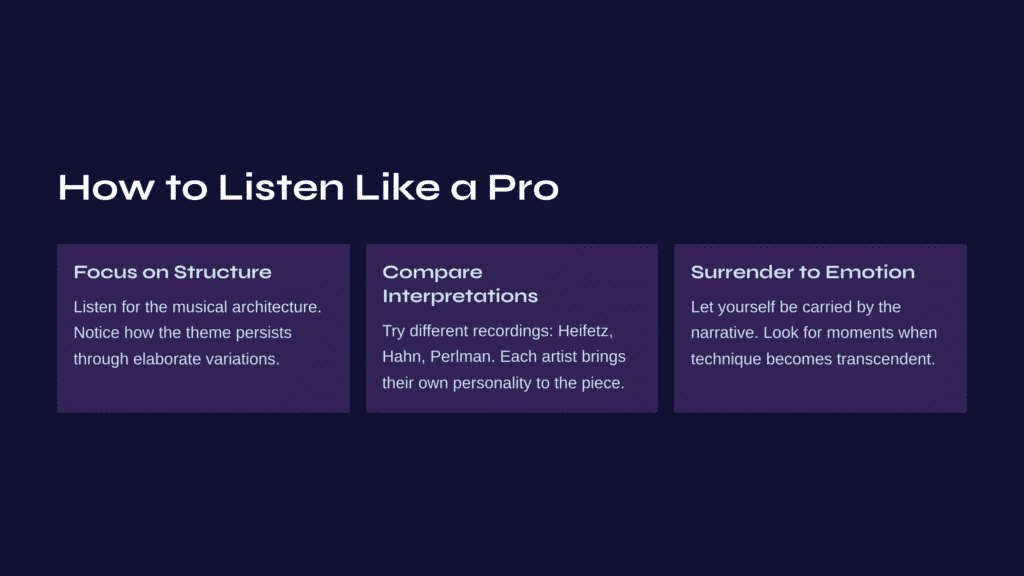
How to Listen Like a Pro
When approaching Caprice No. 24, resist the temptation to focus solely on the technical pyrotechnics – though they’re certainly spectacular. Instead, listen for the underlying musical architecture that holds everything together. Pay attention to how Paganini maintains the character of the original theme even through the most elaborate variations. It’s like watching a master architect build increasingly complex structures on the same foundation.
Try listening to different recordings to understand how interpretation affects this music. Compare Jascha Heifetz’s classic approach with more contemporary performers like Hilary Hahn or Itzhak Perlman. Notice how each artist brings their own personality to the piece while respecting its essential character. Some emphasize the dramatic elements, others find the hidden poetry within the virtuosity.
Don’t worry if you can’t follow every technical detail – even professional musicians find new things to discover with each listening. Instead, let yourself be carried along by the musical narrative. Listen for the moments when technique becomes transcendent, when you forget about the impossibility of what you’re hearing and simply surrender to the emotional impact. That’s when you’ll understand why this piece has held audiences spellbound for over two hundred years.
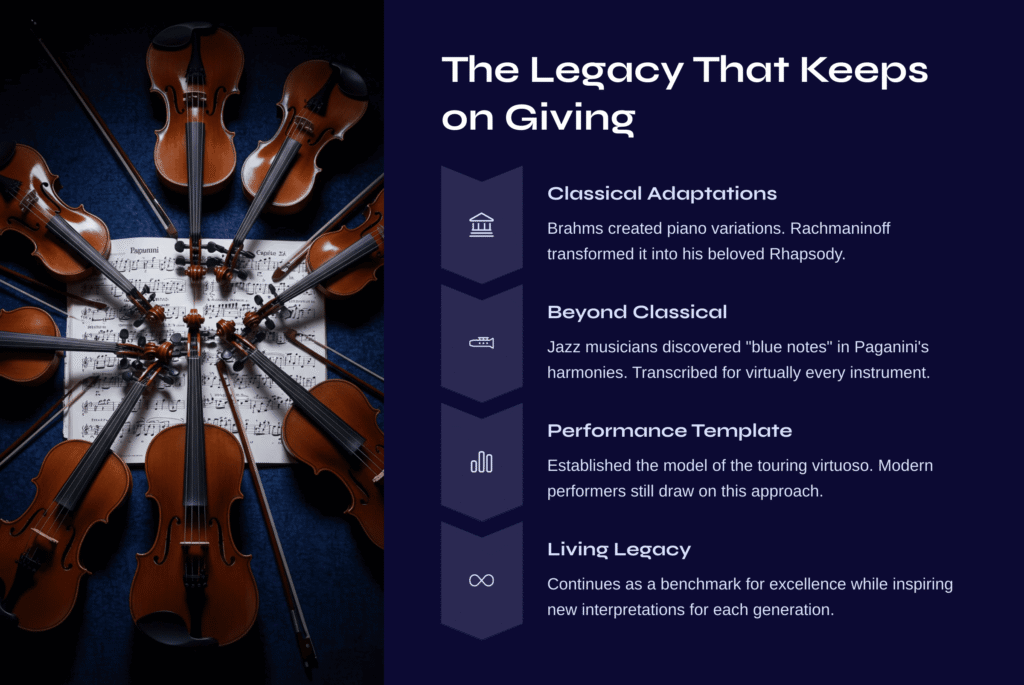
The Legacy That Keeps on Giving
The influence of Caprice No. 24 extends far beyond the violin world. That unforgettable theme has become one of the most borrowed melodies in classical music history. Brahms built an entire set of piano variations around it, creating what Clara Schumann dubbed the “Hexenvariationen” (Witch’s Variations) for their diabolical difficulty. Rachmaninoff transformed it into his beloved Rhapsody on a Theme of Paganini, where the theme blooms into one of the most romantic melodies ever written for piano and orchestra.
But the influence doesn’t stop with classical music. Jazz musicians have discovered the “blue notes” hidden in Paganini’s harmonies, recognizing techniques that wouldn’t become common in jazz for another century. The piece has been transcribed for virtually every instrument, from trumpet to cello, proving that its musical appeal transcends the specific capabilities of the violin.
Perhaps most importantly, Caprice No. 24 established the template for what we now call the touring virtuoso. Paganini didn’t just play music; he created an experience that combined technical mastery with theatrical presentation. Modern performers from David Garrett to Lindsey Stirling still draw on this model, using virtuosity as a means of connecting with audiences on both intellectual and emotional levels.
The piece continues to serve as a benchmark for violin excellence, a standard against which technical and musical achievement is measured. But it’s also a living piece of art that continues to inspire new interpretations and arrangements, proving that truly great music transcends the circumstances of its creation to speak to each new generation in its own voice.
This is what makes Paganini’s final caprice so remarkable – it’s simultaneously a historical document of early 19th-century violin technique and a piece of music that feels as fresh and challenging today as it did two centuries ago. In an age of digital perfection and auto-tune, there’s something profoundly moving about music that demands everything from its performers and rewards both artists and audiences with an experience that technology simply cannot replicate. It reminds us that the human spirit, when pushed to its limits, is capable of creating beauty that feels truly miraculous.

If You Loved This, Listen to This Next
If you were mesmerized by Paganini’s supernatural virtuosity and the way technical mastery can create genuine musical magic in Caprice No. 24, you’ll find yourself equally enchanted by When Midnight Strikes: Saint-Saëns’ Danse Macabre – where similar dramatic intensity and brilliant orchestral writing conjure an entirely different kind of musical sorcery that dances on the edge between the earthly and the otherworldly.
Both works reveal how composers can harness extraordinary technical demands to create music that transcends mere performance, becoming theatrical experiences that continue to captivate audiences with their blend of virtuosic brilliance and spine-tingling atmosphere.
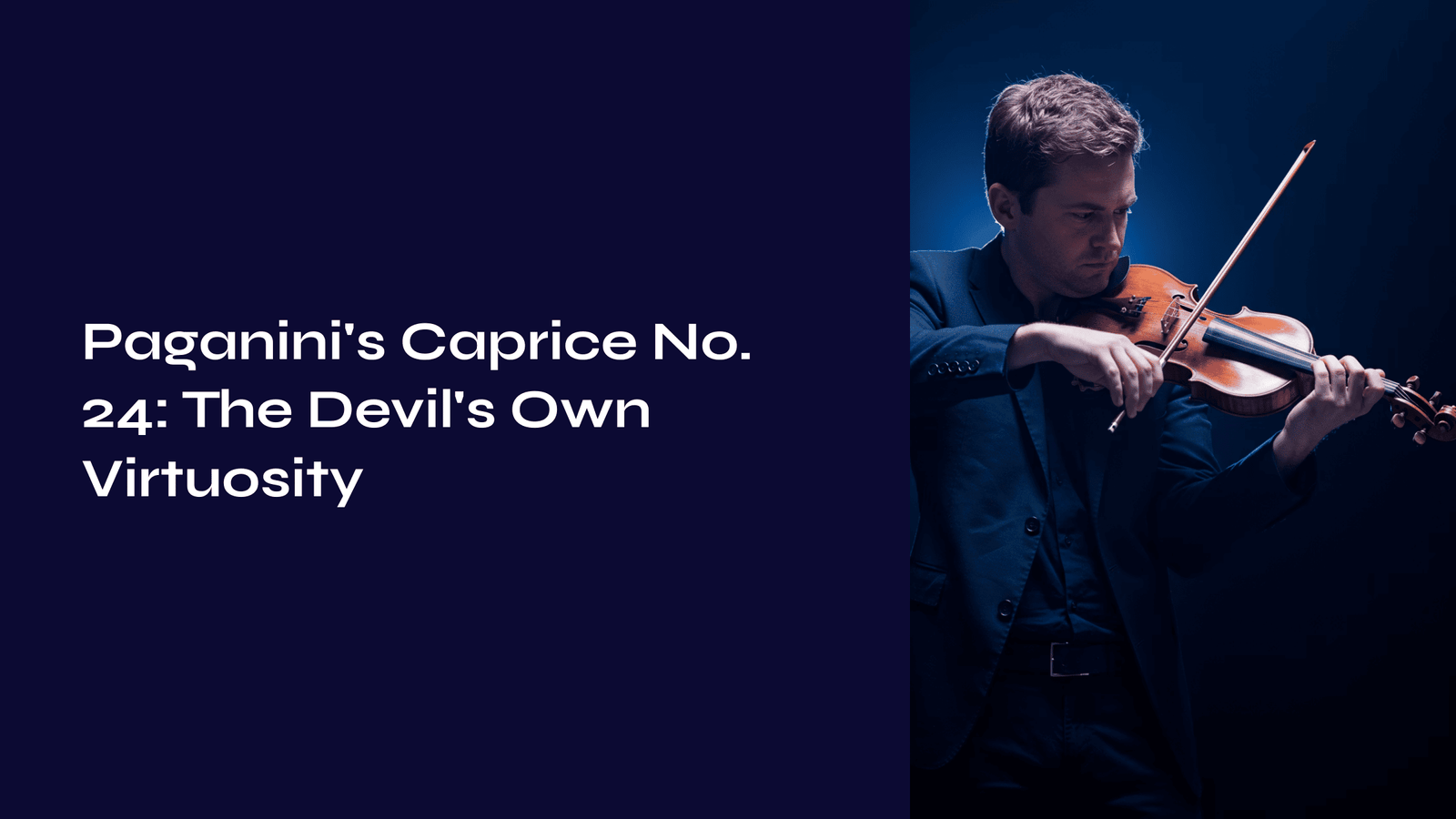

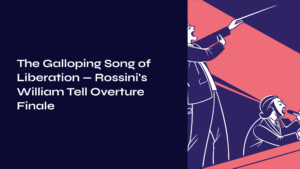
![Read more about the article Air Cooled CPU vs Water Cooled CPU: Choose the right cooling system for PCs out of 2 [Part.1]](https://rvmden.com/wp-content/uploads/2024/01/Air-Cooled-CPU-vs-300x169.png)